
The Eight Great Temples in the Western Hills is a Buddhism temple park with a long history and abundant historical relics. Hundreds of years, the landscape is famous for "Three Hills, Eight Temples, and Twelve Scenes". The Park got its name from eight ancient temples which are well preserved in conditions.
The Temple of Eternal Peace (Chang'an Temples)
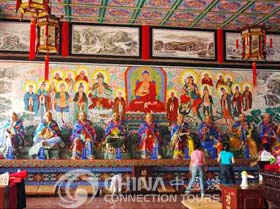 The Temple of Eternal Peace is situated on the plain at the foot of Cuiwei Hill. Constructed in 1504 during the Ming Dynasty, the temple is comprised of two courtyards, the first containing the Sakyamnuni Hall and the second the Niangniang (a female deity) Hall. The Sakyamuni Hall houses a bronze statue of Guan Yu, a hero of the Three Kingdoms period who was later worshiped as the God of War. Chinese Buddhists worshiped Guan Yu as a temple guardian. In the south corner of the covered corridor in the rear part of the hall is a bronze bell cast in 1600 by imperial command. In front of the Sakyamuni Hall there is an urn-shaped bell struck as part of Buddhist rituals, which also dates from the Ming Dynasty. In the rear courtyard there are two white pines (also known as dragon-claw pines) reputed to date from the Yuan Dynasty.
The Temple of Eternal Peace is situated on the plain at the foot of Cuiwei Hill. Constructed in 1504 during the Ming Dynasty, the temple is comprised of two courtyards, the first containing the Sakyamnuni Hall and the second the Niangniang (a female deity) Hall. The Sakyamuni Hall houses a bronze statue of Guan Yu, a hero of the Three Kingdoms period who was later worshiped as the God of War. Chinese Buddhists worshiped Guan Yu as a temple guardian. In the south corner of the covered corridor in the rear part of the hall is a bronze bell cast in 1600 by imperial command. In front of the Sakyamuni Hall there is an urn-shaped bell struck as part of Buddhist rituals, which also dates from the Ming Dynasty. In the rear courtyard there are two white pines (also known as dragon-claw pines) reputed to date from the Yuan Dynasty.
The Temple of Divine Light (Lingguang Temples)
Less than half a kilometer up Cuiwei Hill one comes to the Temple of Divine Light. Originally called the Dragon Spring Temple, its name was changed to the Mountain of Awakening Temple in 1162. The Temple of Divine Light originally contained a number of fine old buildings, carvings and statues, but the Eight-Power Allied Forces destroyed all these when they occupied Beijing in 1900. One notable structure was a large octagonal Liao Dynasty pagoda constructed in 1071 of carved bricks. In 1956, the People's Government erected a new 13-story pagoda on the site of the Liao foundation and named it the "Pagoda of the Buddha's Tooth."
Three-Hill Convent (Sanshan'an)
A short distance from the Temple of Divine Light stands the Three-Hill Convent, which derives its name from the fact that it is situated between Cuiwei Hill, Pingpo Hill and Lushi Hill. Though the convent is not large and consists of only one courtyard, it is of rather exquisite construction. At the doorway of the main hall there is a rectangular "Cloud and Water Stone," carved with images of scenery, human figures and animals. To the east of the main hall is a small kiosk with an inscribed plaque that reads, "Cuiwei Hill is part of a painting." The Three-Hill Convent is a common starting point for mountaineering.
The Temple of Great Mercy (Dabei Temples)
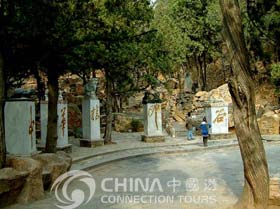 Climbing up from the Three-Hill Convent, one passes many strange rock formations before arriving at the fourth of the Eight Great Temples, the Temple of Great Mercy. The three main halls in the temple complex date from different eras of the Ming Dynasty; the most recently built being the rearmost Hall of Great Mercy. On the front hall hangs a plaque inscribed with the words "Sea of Mercy," and the courtyard before it is densely planted with a rare species of bamboo that remains green throughout the winter. The courtyards also contain potted landscapes, fragrant plants and decorative rockeries. Also of interest to sightseers are the two huge gingko trees in the rear courtyard, reputed to be more than 800 years old. The carved statues of the 18 Arhats in the front hall of the temple are some of the finest in all of the Eight Great Temples.
Climbing up from the Three-Hill Convent, one passes many strange rock formations before arriving at the fourth of the Eight Great Temples, the Temple of Great Mercy. The three main halls in the temple complex date from different eras of the Ming Dynasty; the most recently built being the rearmost Hall of Great Mercy. On the front hall hangs a plaque inscribed with the words "Sea of Mercy," and the courtyard before it is densely planted with a rare species of bamboo that remains green throughout the winter. The courtyards also contain potted landscapes, fragrant plants and decorative rockeries. Also of interest to sightseers are the two huge gingko trees in the rear courtyard, reputed to be more than 800 years old. The carved statues of the 18 Arhats in the front hall of the temple are some of the finest in all of the Eight Great Temples.
The Temple of Dragon King (Longwangtang)
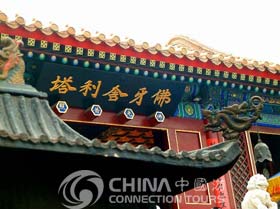 The Temple of Dragon King, located to the northwest of the Temple of Great Mercy, is also known as Dragon Spring Convent. It was built in early Qing Dynasty. Entering the temple, one first notices the sound of a bubbling spring breaking the stillness. The spring bubbles up from beneath a cliff behind the second courtyard and flows through the first courtyard and out of a carved stone spigot in the shape of a dragon's head into a pond. The water of this eternally flowing spring is clear and sweet and never freezes in winter. The Pavilion for Listening to the spring stands nearby. Behind the pond is the Hall of the Dragon King, which according to a local legend, is the residence of the Dragon King. The hall is surrounded by luxuriant green bamboo. The Pavilion of Reclining Leisure and the Pavilion for Listening to the spring, both of which are built against the mountain, are fine spots for viewing the distant hills.
The Temple of Dragon King, located to the northwest of the Temple of Great Mercy, is also known as Dragon Spring Convent. It was built in early Qing Dynasty. Entering the temple, one first notices the sound of a bubbling spring breaking the stillness. The spring bubbles up from beneath a cliff behind the second courtyard and flows through the first courtyard and out of a carved stone spigot in the shape of a dragon's head into a pond. The water of this eternally flowing spring is clear and sweet and never freezes in winter. The Pavilion for Listening to the spring stands nearby. Behind the pond is the Hall of the Dragon King, which according to a local legend, is the residence of the Dragon King. The hall is surrounded by luxuriant green bamboo. The Pavilion of Reclining Leisure and the Pavilion for Listening to the spring, both of which are built against the mountain, are fine spots for viewing the distant hills.
The Temple of Fragrant World (Xiangjie Temples)
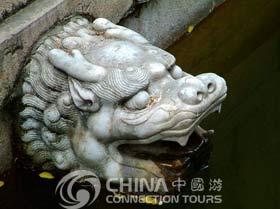 Also known as the Pingpo Temple, the Temple of the Fragrant World is the largest temple complex in the entire area. In the past, it served as the summer villa of Chinese emperors. Even today the Imperial Palace and Scripture Repository erected by Emperor Qianlong can still be seen. The temple also contains numerous historical relics as well as paintings and calligraphy by known artists. The Pingpo Temple, named after the hill on which it was built, has a history traceable back to the Tang Dynasty. In the 15th century, when a Ming princess named Cuiwei was buried here, the hill was named after her. The temple was rebuilt and renamed three times, its present name being bequeathed in 1748 by Emperor Qianlong. The extant buildings all date from the Ming and Qing dynasties.
Also known as the Pingpo Temple, the Temple of the Fragrant World is the largest temple complex in the entire area. In the past, it served as the summer villa of Chinese emperors. Even today the Imperial Palace and Scripture Repository erected by Emperor Qianlong can still be seen. The temple also contains numerous historical relics as well as paintings and calligraphy by known artists. The Pingpo Temple, named after the hill on which it was built, has a history traceable back to the Tang Dynasty. In the 15th century, when a Ming princess named Cuiwei was buried here, the hill was named after her. The temple was rebuilt and renamed three times, its present name being bequeathed in 1748 by Emperor Qianlong. The extant buildings all date from the Ming and Qing dynasties.
The Cave of Precious Pearls (Baozhudong)
On the steep path that leads up the hill from the Temple of the Fragrant World, there stands a memorial archway with the inscription, "Place of Happiness" on one side and "Forest of Solidity" on the other. There is also a large grotesque rock inscribed with poems in the calligraphy of various emperors. The hall erected behind this archway is the famous Temple of Precious Pearls. The temple's name comes from the cavern behind the main hall and stone near its entrance, which resembles a large pearl. Though the floor area of the cave is no more than 25 square meters, a Qing monk named Hai Xiu lived there for 40 years. A status of this Long-term resident standing inside the cavern is popularly known as the "King-of-the-Ghost-Bodhisattva."
The Mysterious Devil's Cliff (Mimoyan)
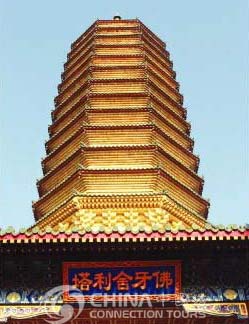 Heading north down the hill from the Cave of Precious Pearls and climbing up Lushi Hill, one passes through a dense grove of trees before coming to an old temple known as the Temple of Buddha hood or the Temple of Pacifying the Nation. Inside the temple courtyard there are exquisitely wrought rockery hills. The Temple of Buddha hood, one of the older and large temples in the area, was first built in the Sui and Tang period more than 1,200 years ago. The name was changed several times during the ages, yet each of these changes reflected the temple's close association with Lu Shi and his auspicious dragons. The present name of the temple was fixed in 1460 during the Ming Dynasty, and many of the buildings that remain show evidence of Ming architectural style.
Heading north down the hill from the Cave of Precious Pearls and climbing up Lushi Hill, one passes through a dense grove of trees before coming to an old temple known as the Temple of Buddha hood or the Temple of Pacifying the Nation. Inside the temple courtyard there are exquisitely wrought rockery hills. The Temple of Buddha hood, one of the older and large temples in the area, was first built in the Sui and Tang period more than 1,200 years ago. The name was changed several times during the ages, yet each of these changes reflected the temple's close association with Lu Shi and his auspicious dragons. The present name of the temple was fixed in 1460 during the Ming Dynasty, and many of the buildings that remain show evidence of Ming architectural style.

